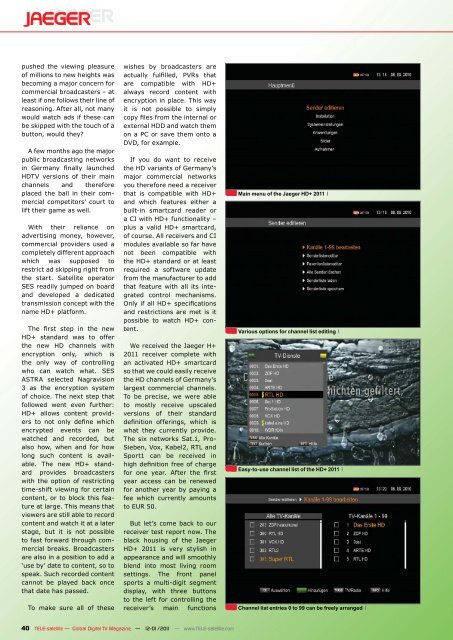TELEsatelit - TELE-satellite International Magazine
TELEsatelit - TELE-satellite International Magazine
TELEsatelit - TELE-satellite International Magazine
Create successful ePaper yourself
Turn your PDF publications into a flip-book with our unique Google optimized e-Paper software.
pushed the viewing pleasure<br />
of millions to new heights was<br />
becoming a major concern for<br />
commercial broadcasters – at<br />
least if one follows their line of<br />
reasoning. After all, not many<br />
would watch ads if these can<br />
be skipped with the touch of a<br />
button, would they?<br />
A few months ago the major<br />
public broadcasting networks<br />
in Germany finally launched<br />
HDTV versions of their main<br />
channels and therefore<br />
placed the ball in their commercial<br />
competitors’ court to<br />
lift their game as well.<br />
With their reliance on<br />
advertising money, however,<br />
commercial providers used a<br />
completely different approach<br />
which was supposed to<br />
restrict ad skipping right from<br />
the start. Satellite operator<br />
SES readily jumped on board<br />
and developed a dedicated<br />
transmission concept with the<br />
name HD+ platform.<br />
The first step in the new<br />
HD+ standard was to offer<br />
the new HD channels with<br />
encryption only, which is<br />
the only way of controlling<br />
who can watch what. SES<br />
ASTRA selected Nagravision<br />
3 as the encryption system<br />
of choice. The next step that<br />
followed went even further:<br />
HD+ allows content providers<br />
to not only define which<br />
encrypted events can be<br />
watched and recorded, but<br />
also how, when and for how<br />
long such content is available.<br />
The new HD+ standard<br />
provides broadcasters<br />
with the option of restricting<br />
time-shift viewing for certain<br />
content, or to block this feature<br />
at large. This means that<br />
viewers are still able to record<br />
content and watch it at a later<br />
stage, but it is not possible<br />
to fast forward through commercial<br />
breaks. Broadcasters<br />
are also in a position to add a<br />
‘use by’ date to content, so to<br />
speak. Such recorded content<br />
cannot be played back once<br />
that date has passed.<br />
To make sure all of these<br />
wishes by broadcasters are<br />
actually fulfilled, PVRs that<br />
are compatible with HD+<br />
always record content with<br />
encryption in place. This way<br />
it is not possible to simply<br />
copy files from the internal or<br />
external HDD and watch them<br />
on a PC or save them onto a<br />
DVD, for example.<br />
If you do want to receive<br />
the HD variants of Germany’s<br />
major commercial networks<br />
you therefore need a receiver<br />
that is compatible with HD+<br />
and which features either a<br />
built-in smartcard reader or<br />
a CI with HD+ functionality –<br />
plus a valid HD+ smartcard,<br />
of course. All receivers and CI<br />
modules available so far have<br />
not been compatible with<br />
the HD+ standard or at least<br />
required a software update<br />
from the manufacturer to add<br />
that feature with all its integrated<br />
control mechanisms.<br />
Only if all HD+ specifications<br />
and restrictions are met is it<br />
possible to watch HD+ content.<br />
We received the Jaeger H+<br />
2011 receiver complete with<br />
an activated HD+ smartcard<br />
so that we could easily receive<br />
the HD channels of Germany’s<br />
largest commercial channels.<br />
To be precise, we were able<br />
to mostly receive upscaled<br />
versions of their standard<br />
definition offerings, which is<br />
what they currently provide.<br />
The six networks Sat.1, Pro-<br />
Sieben, Vox, Kabel2, RTL and<br />
Sport1 can be received in<br />
high definition free of charge<br />
for one year. After the first<br />
year access can be renewed<br />
for another year by paying a<br />
fee which currently amounts<br />
to EUR 50.<br />
But let’s come back to our<br />
receiver test report now. The<br />
black housing of the Jaeger<br />
HD+ 2011 is very stylish in<br />
appearance and will smoothly<br />
blend into most living room<br />
settings. The front panel<br />
sports a multi-digit segment<br />
display, with three buttons<br />
to the left for controlling the<br />
receiver’s main functions<br />
40 <strong>TELE</strong>-<strong>satellite</strong> — Global Digital TV <strong>Magazine</strong> — 12-01/2011 — www.<strong>TELE</strong>-<strong>satellite</strong>.com<br />
Main menu of the Jaeger HD+ 2011<br />
Various options for channel list editing<br />
Easy-to-use channel list of the HD+ 2011<br />
Channel list entries 0 to 99 can be freely arranged

















